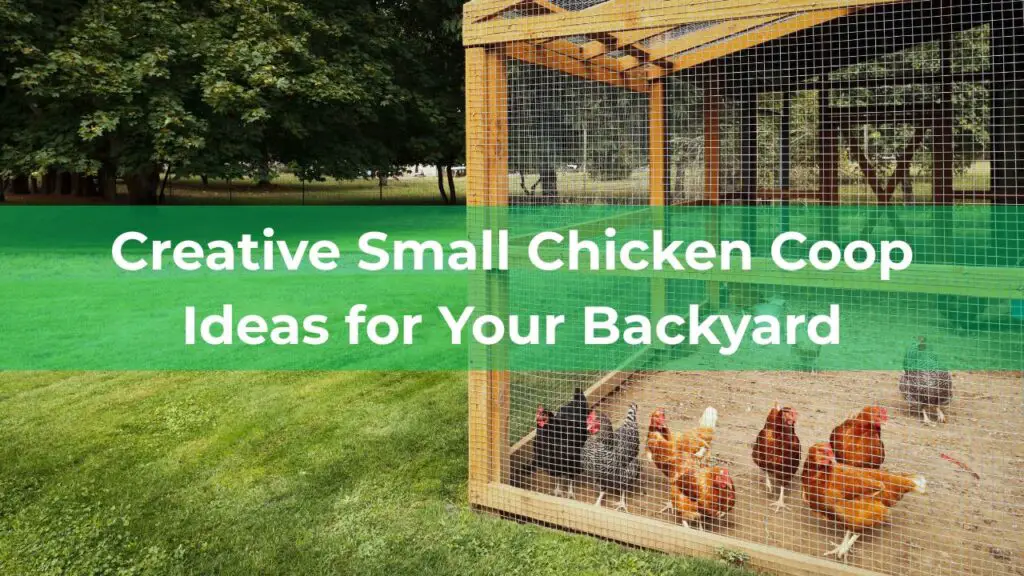Disclosure!
At The Daily Farming, your trust means everything. We use AI to help create some of our content, but every post is carefully reviewed and edited by real humans before it’s published.
Some of our images are AI-generated to help illustrate ideas, but everything you see is checked and approved by us.
Thanks for being here—we’re grateful for you!
So… you’re thinking about getting chickens. Awesome choice.
But maybe you’re not working with acres of rolling farmland. Maybe you’ve got, I don’t know… a backyard the size of a large bath mat? Totally fine. You don’t need a big space to keep a few happy hens clucking around. In fact, small chicken coops are kind of the unsung heroes of backyard farming. They’re compact, easier to clean, way cheaper to build or buy—and let’s be honest—some of them are so cute it’s almost ridiculous.
Whether you’ve got two chickens, four, or you’re just chicken-curious, this post is packed with 17 small chicken coop ideas to get your wheels turning. We’re talking clever DIY setups, space-saving designs, and even a few that’ll make your neighbors jealous (yep, chicken coop envy is a thing).
So pull up a chair, pour yourself a cup of something, and let’s chat chicken coops. Tiny ones. Cozy ones. Some that even double as garden art. Ready? Let’s go!
Things to Consider Before Building or Buying a Small Chicken Coop
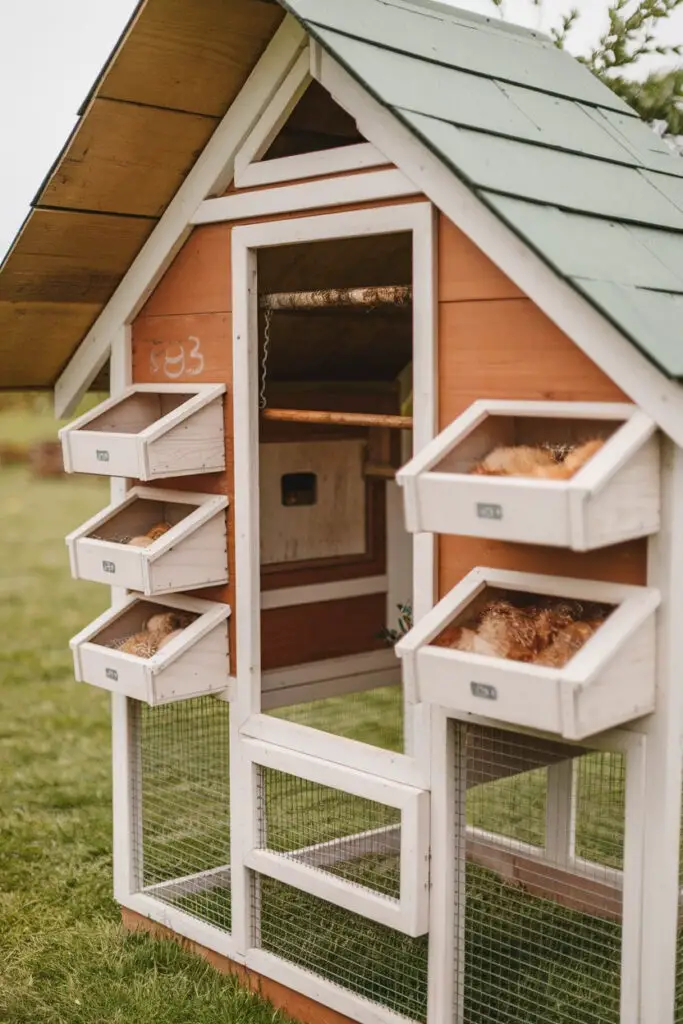
Before you start hammering boards together or clicking “add to cart” on that cute little coop you saw online, there are a few key things you’ll want to think about. Chickens might be low-maintenance compared to, say, a golden retriever with separation anxiety—but they still need a safe, comfy setup to stay happy and healthy.
Let’s break it down.
How Much Space Do Chickens Really Need?
Here’s the deal: chickens don’t need a mansion, but they do need elbow room (or… wing room?). For the coop itself, you’ll want about 2 to 4 square feet per chicken. If you’ve got three hens, that’s roughly the size of a medium dog crate. Cozy, but doable.
Now the run space (a.k.a. their little outdoor playground) is where things open up. Plan on 8–10 square feet per chicken for the run. More if you can swing it.
Thinking about letting them free-range? That’s great! Chickens love to scratch around, snack on bugs, and explore. Just keep in mind: free-ranging = less coop space required, but more supervision and predator awareness. And yes, they will dig up your garden if given the chance. Ask me how I know.
👉 For more creative layout inspiration, check out our post: 13 Creative Chicken Coop Ideas to Inspire Your Backyard Design
Local Laws and Backyard Chicken Regulations
Ah, the less-fun-but-still-important part. Before you fall in love with a coop design, make sure you can actually have chickens where you live.
- Zoning laws: Some cities limit how many chickens you can keep—or don’t allow them at all. (Boo!)
- HOA rules: If you’re in a neighborhood with a homeowners’ association, check their rules. Some HOAs are cool with chickens, others not so much.
- Permits: A few places may require you to pull a permit or register your flock.
Pro tip: Call your city or check their website before you start building. It’s better than getting a surprise visit from the chicken police.
Climate and Weather Protection
Your coop needs to be more than just cute—it needs to keep your chickens comfortable in your local weather.
- Insulation: If you live somewhere cold, your coop should hold in some heat (without turning into a chicken sauna).
- Ventilation: Super important. Chickens are messy little heaters, and their coop needs airflow to stay dry and stink-free.
- Shade and rain protection: In hot climates, make sure your girls have some shade. Rain? Make sure water doesn’t pool inside the run or coop.
A well-designed small coop can handle all kinds of weather—it’s just about planning ahead.
Safety From Predators
Here’s a not-so-fun fact: everything wants to eat your chickens. Raccoons, foxes, hawks, coyotes… even the neighbor’s cat might get curious.
Luckily, you don’t need a fortress—just smart design:
- Use hardware cloth (not chicken wire!) to keep out sneaky paws.
- Install latches on every door—raccoons have creepy little hands and zero shame.
- Consider an elevated coop for extra protection at night.
If you’re building your own coop, take a peek at this: 16 Affordable DIY Chicken Coop Designs for Your Backyard — it’s packed with smart, budget-friendly options that don’t skimp on safety.
DIY vs. Store-Bought: What’s Right for You?
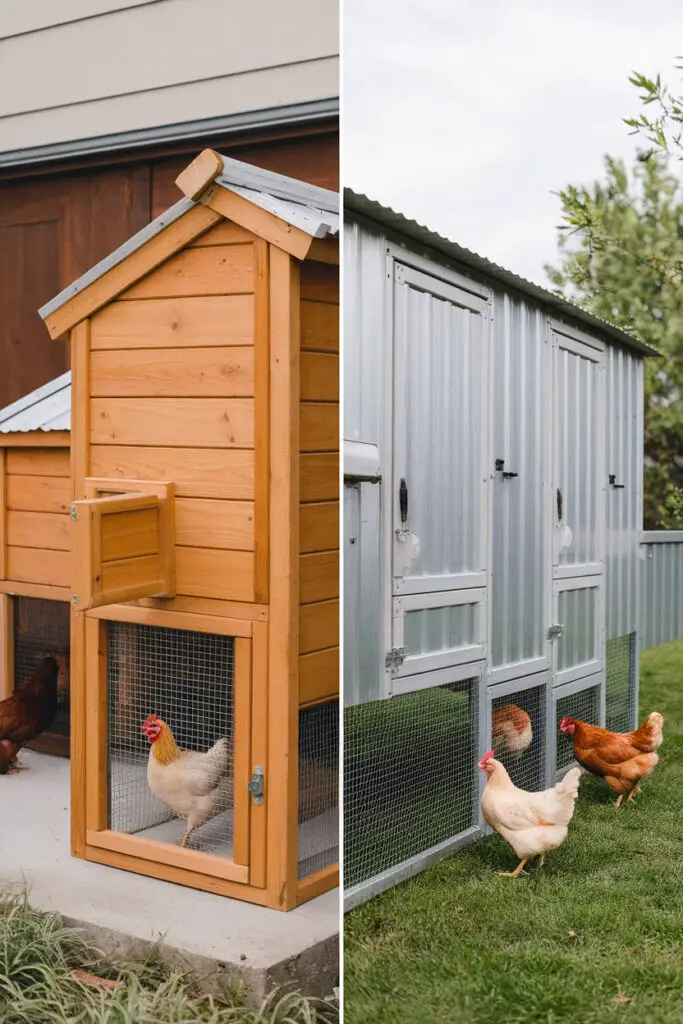
So you’ve decided you want a small chicken coop—great! Now comes the big question:
Should you build one yourself or just buy one ready to go?
Honestly, there’s no wrong answer here. It all comes down to your budget, your skills (or lack thereof—no judgment), and how much time you’ve got on your hands. Let’s look at both options so you can figure out what makes the most sense for you and your flock.
Pros of Building Your Own Small Chicken Coop
Cost-Saving
One of the biggest perks of DIY? It’s usually cheaper—if you’ve got some basic tools lying around and you don’t go rogue at the hardware store. A lot of folks even build coops using reclaimed wood, pallets, or repurposed sheds. You can get seriously creative on a tight budget.
Looking for inspiration? Check out our post on 16 DIY Cheap Chicken Run Ideas (That Won’t Break the Bank) — perfect for pairing with your homemade coop.
Customization
When you build it yourself, you can tailor the coop exactly to your space and needs. Want a storage shelf for feed? Easy. Want it to match your garden aesthetic? Go for it. Want a little chicken porch with tiny flower boxes? Live your best life.
Personal Satisfaction
There’s something ridiculously satisfying about seeing your hens settle into a coop you built with your own hands. Even if it’s a little crooked. Even if you accidentally paint the door shut. It’s yours, and that’s awesome.
Pros of Buying a Pre-Made Coop
Convenience
Click. Buy. Done. If you’re not handy, don’t own a drill, or simply don’t wanna deal, buying a coop is the fast lane to fresh eggs and happy hens.
Professional Quality
Pre-built coops often come with better structural integrity, predator-proofing, and thoughtful design features—especially if you buy from a well-reviewed brand. Some even include integrated runs, built-in nesting boxes, and removable cleaning trays.
Time-Saving
Let’s be real: building a coop can take days, especially if you’re juggling work, family, and pretending your laundry pile doesn’t exist. Buying one can save you time (and probably a few cuss words).
Budget Breakdown: DIY vs. Pre-Built
DIY Costs
If you already have tools and you’re good at scrounging up free materials, you might be able to build a basic small coop for under $100. More realistic DIY budgets (with new wood, hardware cloth, hinges, etc.) fall between $150–$400.
Keep in mind: Time is money too. And chicken math is real—what starts as “I’ll just build a little box” might turn into “Hmm… do I need a solar-powered automatic door?” (You might.)
Pre-Made Coop Costs
Store-bought small chicken coops range from $200–$1,200+, depending on size, materials, and features. Cheaper ones (under $300) might look cute, but they often need reinforcing to be truly predator-proof.
If you’re planning to add a run too, factor that in. Or better yet, pop over to this post for some design inspo: How to Design the Best Chicken Coop and Garden Layout Ideas. It’ll help you plan your space smartly and avoid rookie mistakes (like putting your coop where it floods every time it rains… oops).
17 Small Chicken Coop Ideas (With Smart Design Tips!)
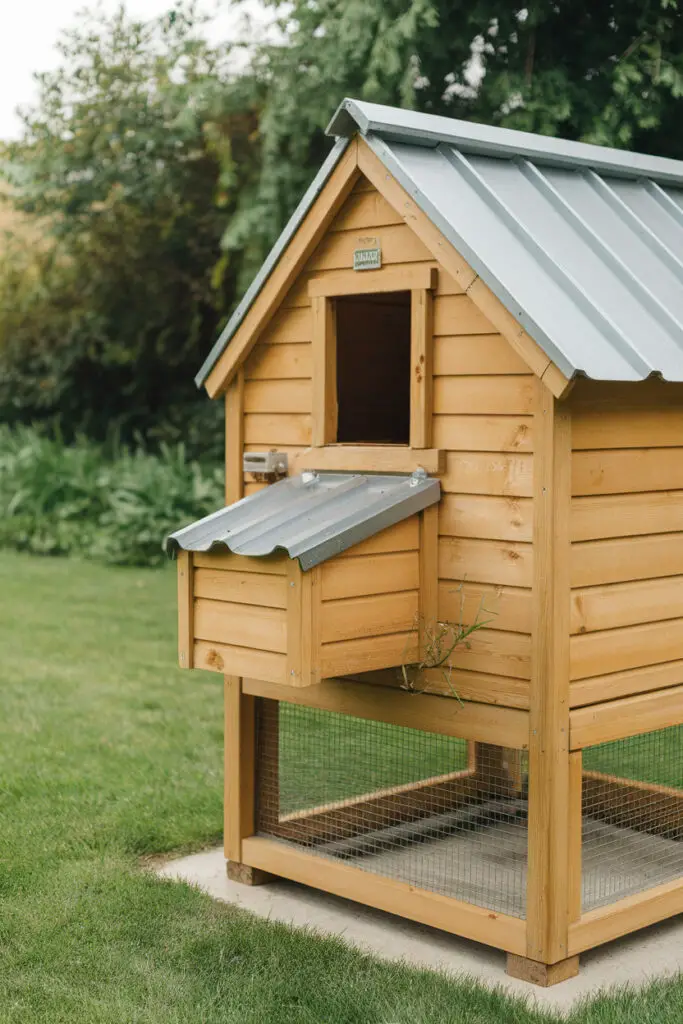
So, you’re short on space but still dreaming of backyard chickens. Good news—you don’t need a sprawling farm to make it happen. With a little creativity (and maybe a drill), you can build or repurpose a coop that fits your space, your style, and your flock.
Here are 7 clever, space-saving chicken coop ideas that prove small can still be mighty.
1. The Raised Garden Coop
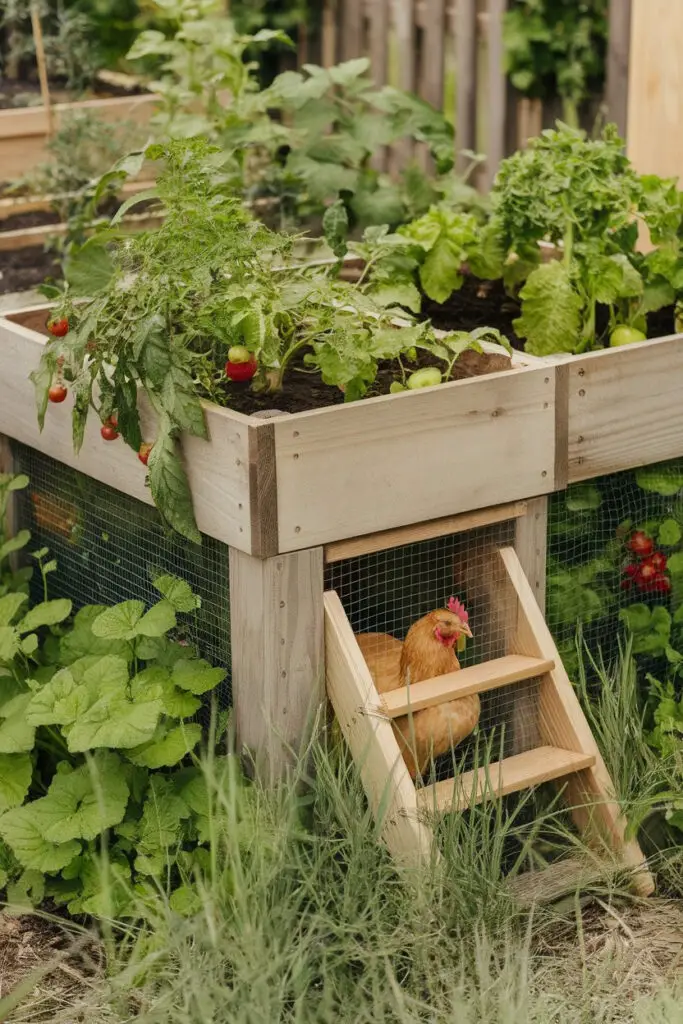
This one’s perfect for the multitaskers and garden lovers out there. The idea? Build your chicken coop under your raised garden beds. Your chickens hang out in the shaded lower level while your herbs and veggies grow on top.
Why it works:
- Great use of vertical space
- Chickens fertilize the garden naturally (hello, nitrogen-rich compost!)
- Keeps the flock cool in summer
Just make sure you reinforce the structure so it doesn’t turn into a muddy mess after the first rain. Bonus tip: install removable trays to make cleaning easier.
You’ll find more inspiration for combining style and function in our post: 14 Creative Chicken House Ideas for Your Backyard Farm!
2. The Repurposed Playhouse
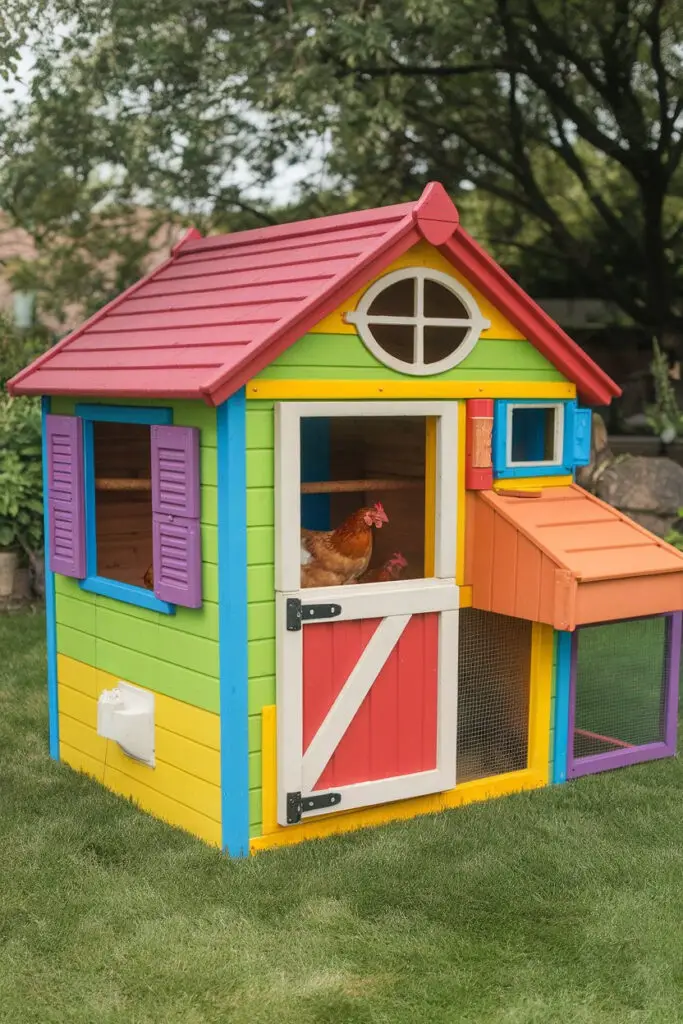
That old plastic playhouse your kids outgrew? Don’t toss it—turn it into a chicken paradise. With a few upgrades (ventilation holes, a door latch, and a roosting bar), you’ve got yourself a colorful, weather-resistant coop that chickens and visitors will love.
Why it works:
- Already weatherproof
- Super easy to clean
- Built-in cuteness
You can even leave the little windows so your hens can peek out and feel like they’re part of the neighborhood. Want to give them the royal roosting treatment? Check out Chicken Roost Ideas – Creative, Safe, and Comfortable Roosting Options for Your Flock! for some fun upgrades.
3. The Coop-and-Storage Combo
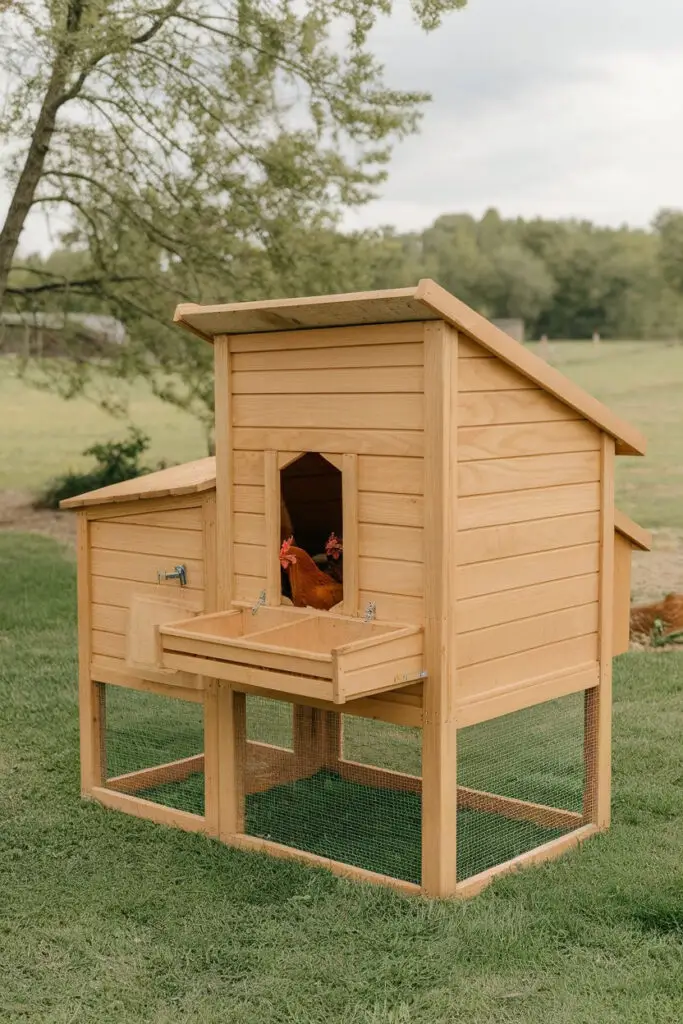
If you’re working with a small backyard, this is a total game-changer. Build a coop on one side and use the other for feed storage, tools, or even a mini gardening bench. Basically, it’s a chicken coop with a junk drawer (but more organized).
Why it works:
- Keeps everything in one place
- Saves space and time
- Looks way tidier than multiple storage bins scattered around
Just make sure you seal off the storage side well—unless you want your chickens nesting in your bag of pine shavings.
4. The Chicken Camper Trailer
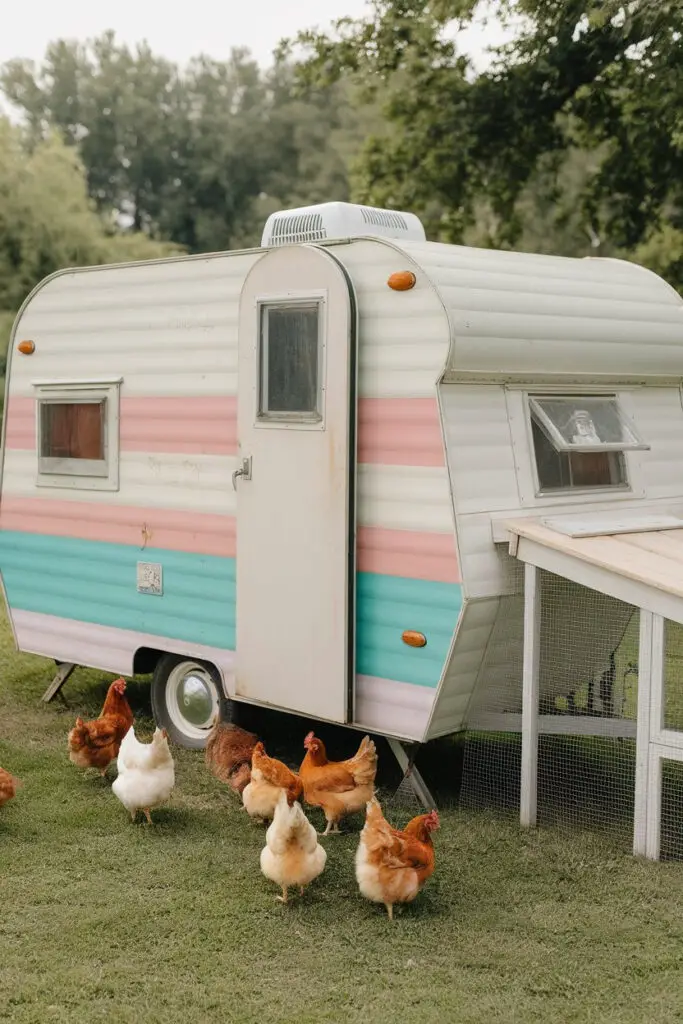
Yes, you read that right. An old camper trailer or teardrop trailer can become the ultimate chicken hangout with a bit of DIY spirit. Paint it fun colors, cut out some windows, and boom—your chickens are road-trip ready (figuratively speaking).
Why it works:
- Already weather-sealed
- Mobile, if you need to relocate
- Just plain awesome
This one’s especially good if you’re into the quirky side of backyard farming. And honestly, who doesn’t want to say, “Yeah, my chickens live in a vintage trailer”?
5. The Greenhouse Coop Combo
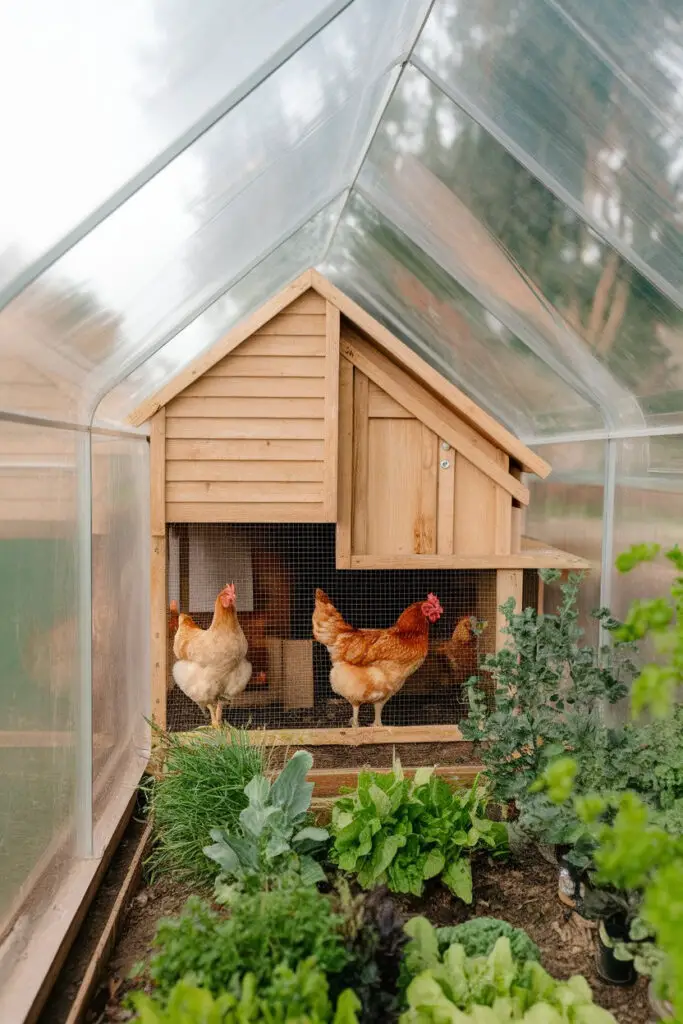
If you’re into sustainability, this one’s for you. Combine a small greenhouse with a chicken coop to create a mini ecosystem. Chickens produce heat and CO2 for the plants, and the plants help regulate moisture and provide natural shade.
Why it works:
- Smart use of energy and space
- Perfect for year-round growing
- Great for colder climates
Pro tip: Keep the coop section on the shadier side and use a clear partition to let in just enough sunlight. It’s like a spa day for your hens and your tomatoes.
6. The Side-Yard Stretch Coop
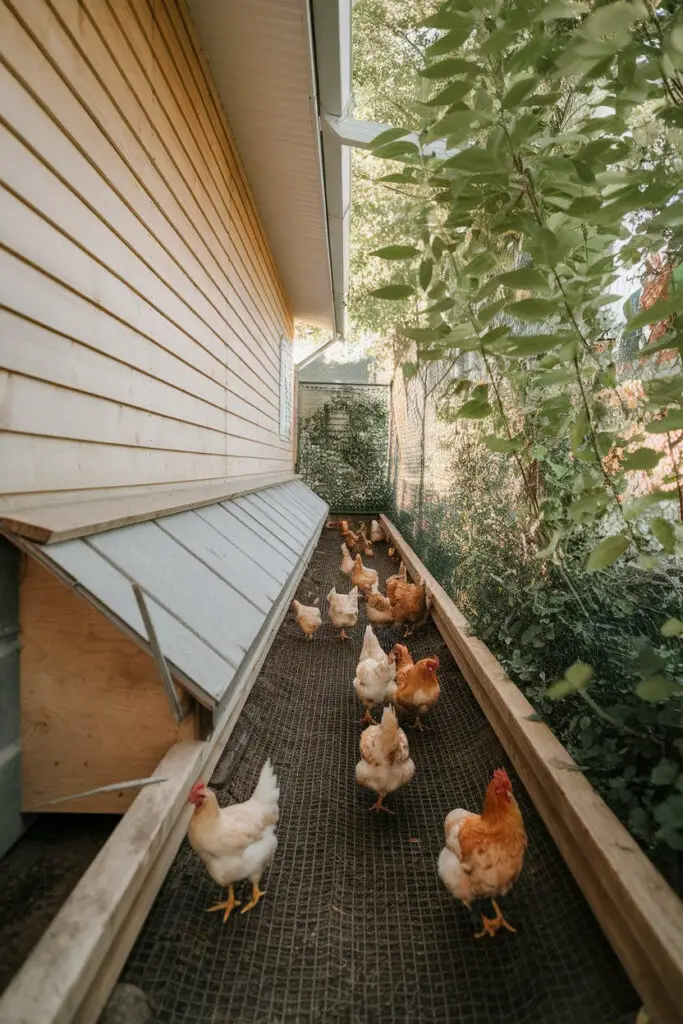
You know that narrow stretch of grass between your house and the fence that you never use? It’s actually the perfect spot for a long, narrow chicken coop and run. Chickens don’t need a ton of width if they have some length to strut their stuff.
Why it works:
- Makes use of otherwise wasted space
- Keeps chickens safe and shaded
- Discreet and out of the way
Just make sure it’s well-ventilated and easy to clean—you don’t want weird smells sneaking into your house.
7. The Upcycled Cabinet Coop

Yes, your grandma’s old armoire can live a second life—as a backyard chicken coop. This one is super budget-friendly and full of charm. You can turn old dressers, bookshelves, or even entertainment centers into chicken homes with a few tweaks.
Why it works:
- Great for tiny flocks (1–3 hens)
- Unique and full of personality
- Keeps things sustainable and low-cost
Paint it, add a roost, and you’ve got a one-of-a-kind coop that’s equal parts adorable and functional. Just be sure to weatherproof it—your chickens probably don’t want waterlogged drawers either.
8. The Deck-Underneath Coop
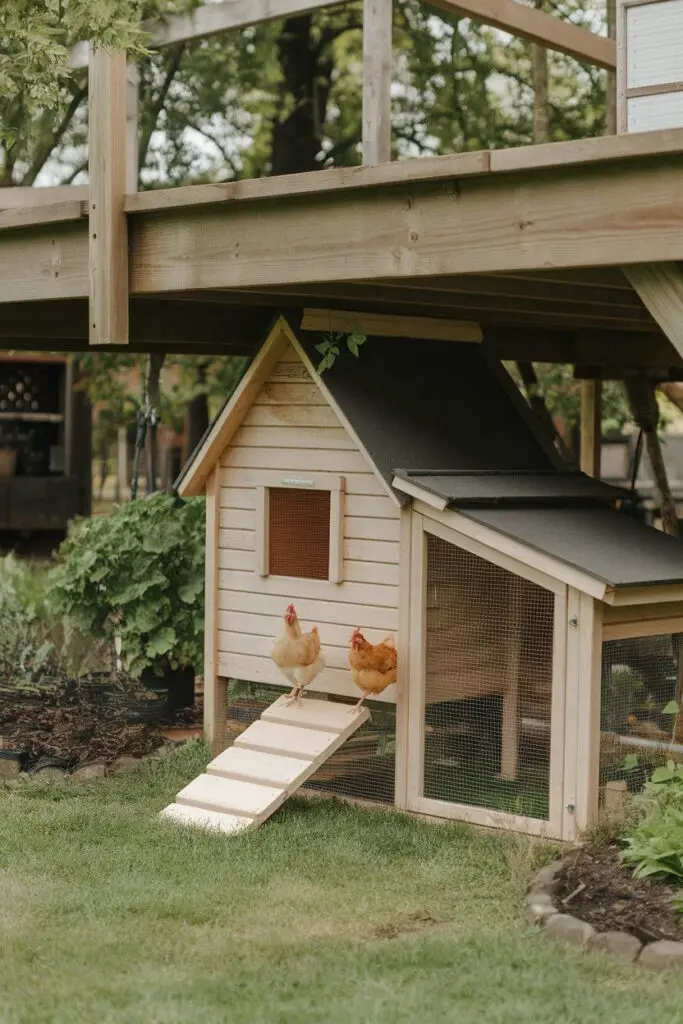
Have a raised deck or porch? Lucky you. That shady, underused space underneath can be turned into a discreet, weather-protected chicken coop. Just enclose it securely, add a ramp, and you’re golden.
Why it works:
- Hidden in plain sight
- Naturally shaded and protected from rain
- Perfect for keeping things tidy and out of view
This one’s a favorite for folks who don’t want their yard to scream “I have chickens!”—even though, let’s be real, that’s something to brag about.
9. The Narrow Coop on Wheels
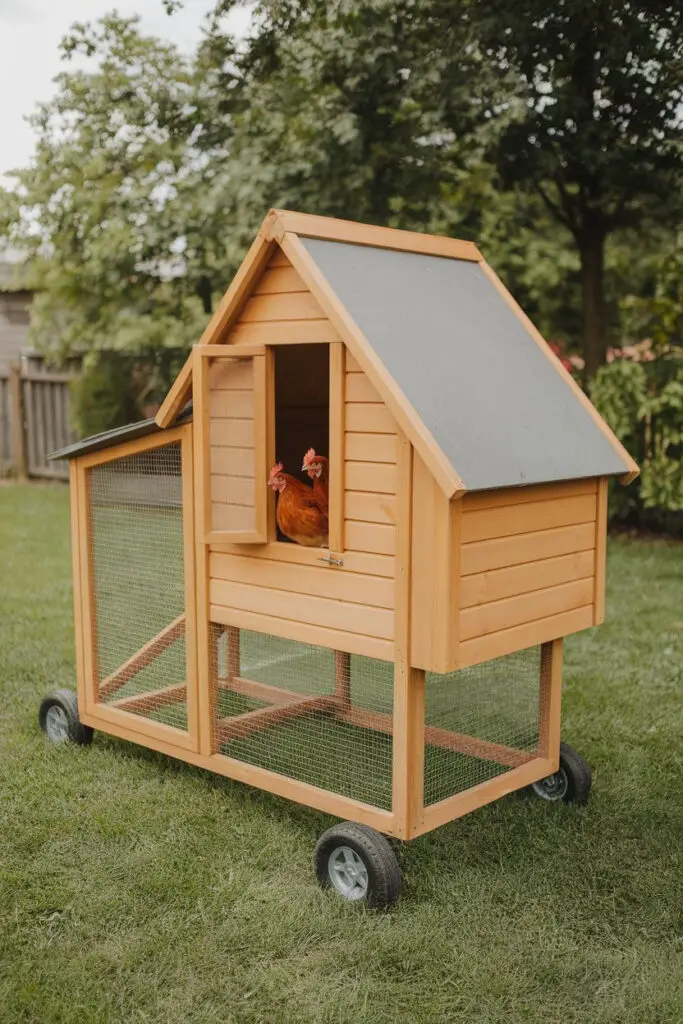
This idea takes the mobile chicken tractor concept and slims it down. Build a narrow, lightweight coop with an attached run, throw some wheels on it, and roll your chickens to fresh grass whenever you feel like switching things up.
Why it works:
- Great for rotating pasture areas
- Keeps your grass from turning into a chicken wasteland
- Easy to clean and reposition
Wheels = freedom. For you and the hens.
10. The Mini Barn Coop
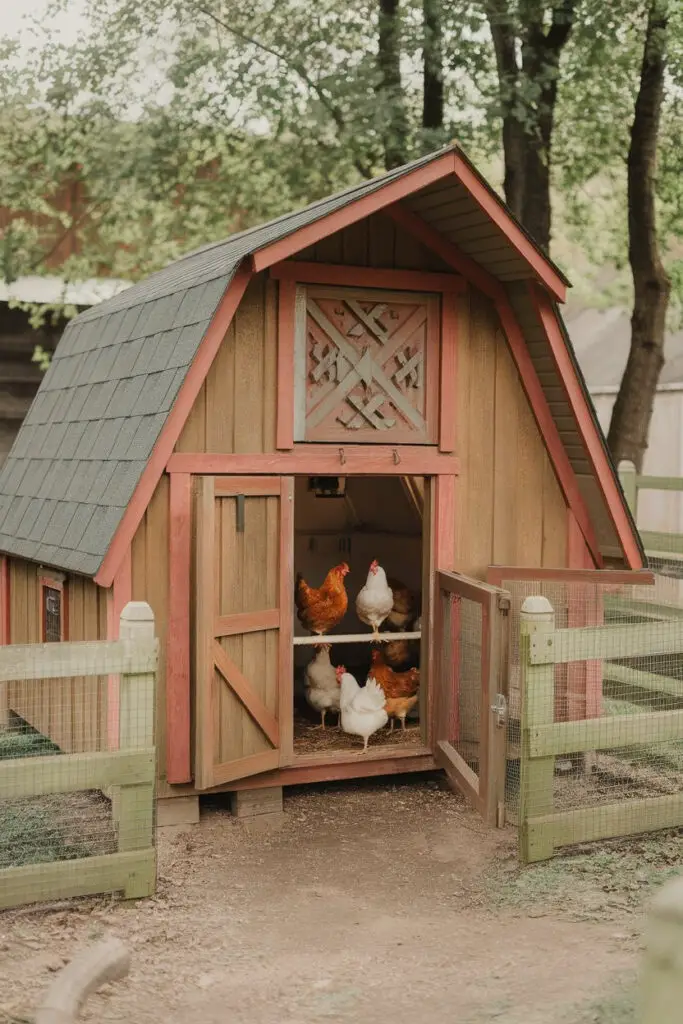
Tiny house meets rustic charm. A barn-style chicken coop, just scaled down. Think pitched roof, maybe some cute little shutters, and red paint if you’re going full farmhouse.
Why it works:
- Classic aesthetic
- Easy to insulate for winter
- Adds charm to any backyard
Want to dress it up even more? Add some hanging flower baskets on the outside. The chickens won’t care, but your neighbors might.
11. The Chicken Pergola
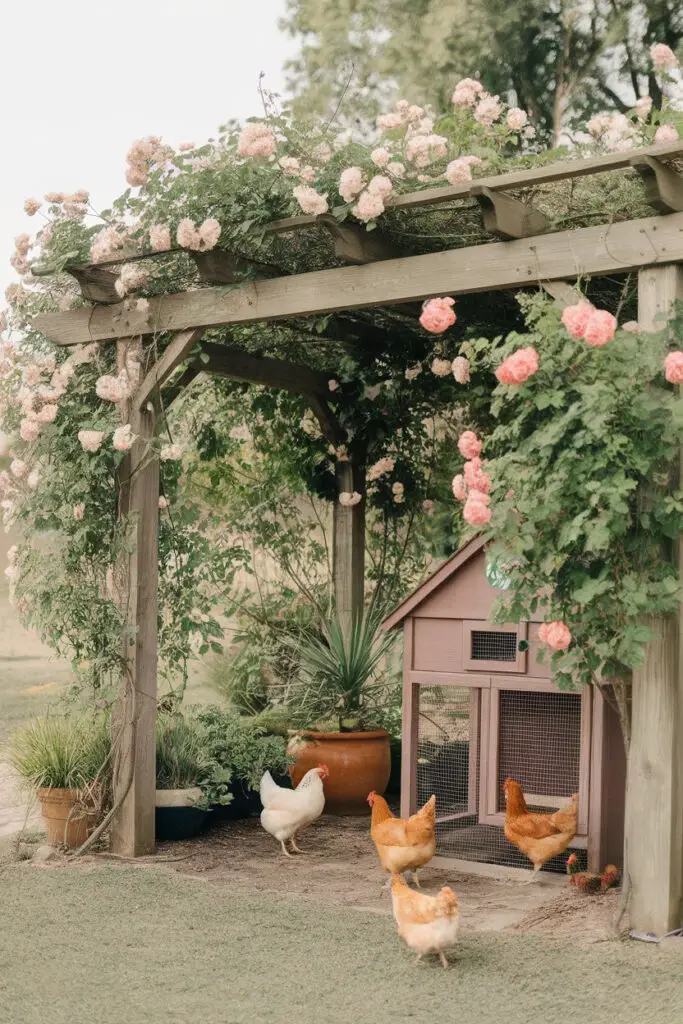
Yes, a coop can be gorgeous. Wrap your coop and run inside a pergola or trellis structure and let some climbing plants do the decorating. Clematis, roses, grapes—whatever grows well in your area.
Why it works:
- Shade + beauty = happy hens and happy humans
- Natural cooling during summer
- Doubles as backyard decor
Just be sure to choose non-toxic plants. No one wants a hen with a bellyache because she nibbled on something suspicious.
12. The Closet Coop

Got an old wooden wardrobe or closet cabinet collecting dust in the garage? Don’t trash it—transform it. Cut out a few windows, add a door latch and some ventilation, and you’ve got a super cozy coop for 2–3 hens.
Why it works:
- Budget-friendly
- Easy to retrofit and customize
- Compact enough for patios or narrow spaces
Add some soft pine shavings and a little perch, and you’ve basically created a chicken Airbnb. (Minus the cleaning fee.)
13. The Side-of-the-Shed Coop

If you already have a garden shed or workshop in your yard, build your coop right off the side. It keeps everything in one zone and saves a ton of space since you’re using an existing structure as one of the coop walls.
Why it works:
- Super efficient footprint
- Easy access to tools, feed, and water
- Can share roof or insulation with the shed
Bonus: attach a gutter system to collect rainwater for the chickens. Sustainability points: unlocked.
14. The Chicken Bungalow with Porch
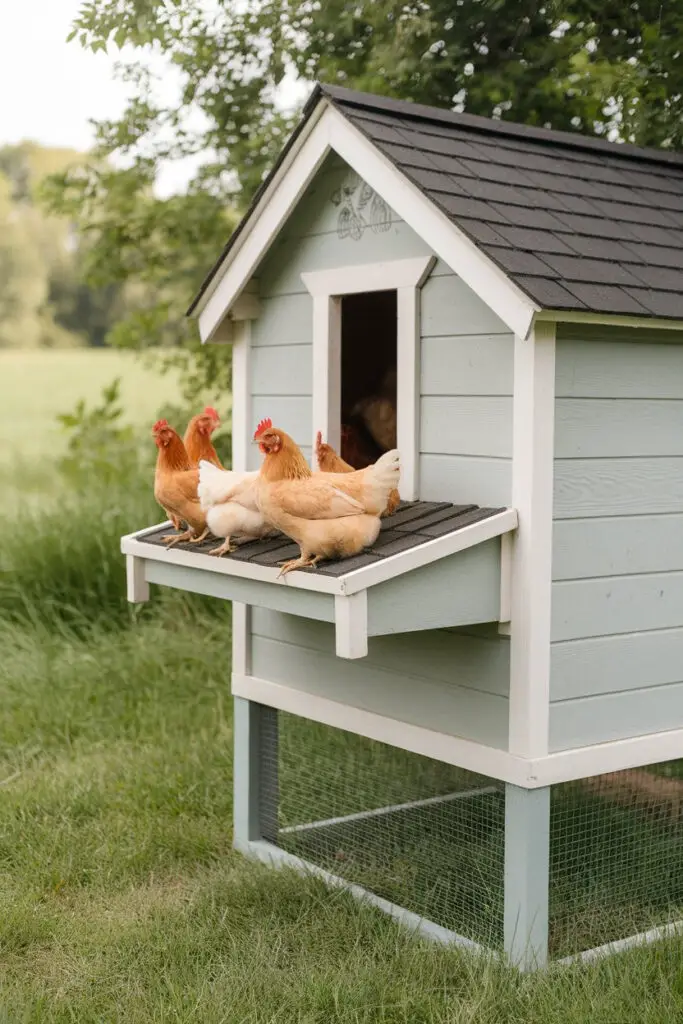
Go a little bougie with your coop. Build a small chicken house with a mini porch or awning—a shady outdoor lounging spot for your flock to hang out during the day.
Why it works:
- Keeps hens cooler in hot weather
- Adds extra lounging space without expanding the footprint too much
- Looks adorable (which, let’s be honest, is half the fun)
Want more ideas that are both stylish and practical? You’ll love our roundup of 14 Creative Chicken House Ideas for Your Backyard Farm!
15. The Shipping Crate Coop
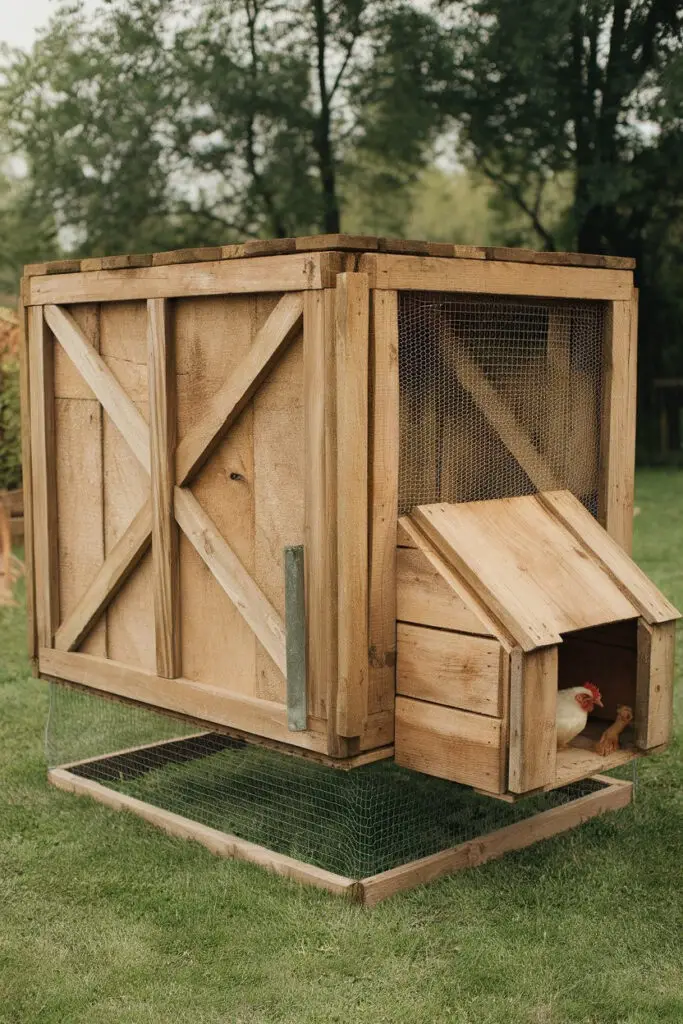
Take a wooden shipping crate—the kind you see at warehouses or sometimes in thrift stores—and turn it into a tiny chicken haven. With some mesh, a few hinges, and a little creativity, you’ve got a coop that’s sturdy, affordable, and totally unique.
Why it works:
- Inexpensive and sustainable
- Easy to customize
- Gives your chickens a cozy, compact home
A shipping crate coop may look small, but it can house a couple of bantams perfectly. Plus, it’s a conversation starter at your next backyard BBQ. “Oh, this old thing? Just a shipping crate coop for my chickens.”
16. The Stackable Chicken Condo
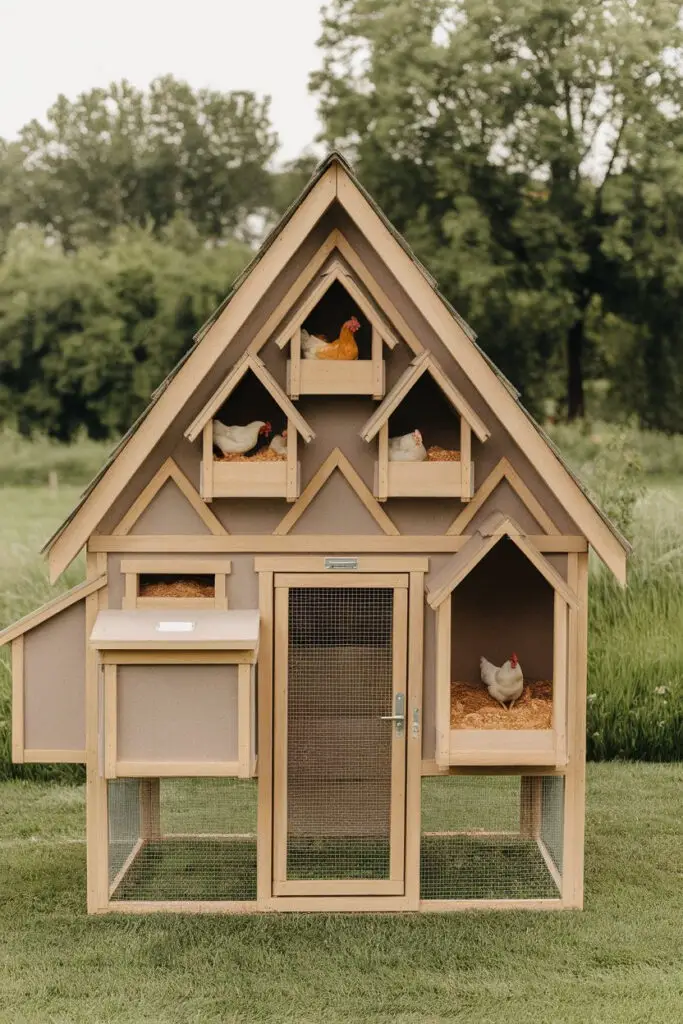
If you’re running low on horizontal space, why not go vertical? Stack a two-level chicken coop with the chickens on the top floor and the run below. You can get creative with the layout—maybe even throw in a little balcony for extra fun.
Why it works:
- Saves space and works in smaller yards
- Gives chickens enough room to roam without sprawling out
- The ultimate tiny house vibe for your chickens
Just keep an eye on ventilation. Your hens need fresh air, especially in stacked coops.
17. The A-Frame Coop
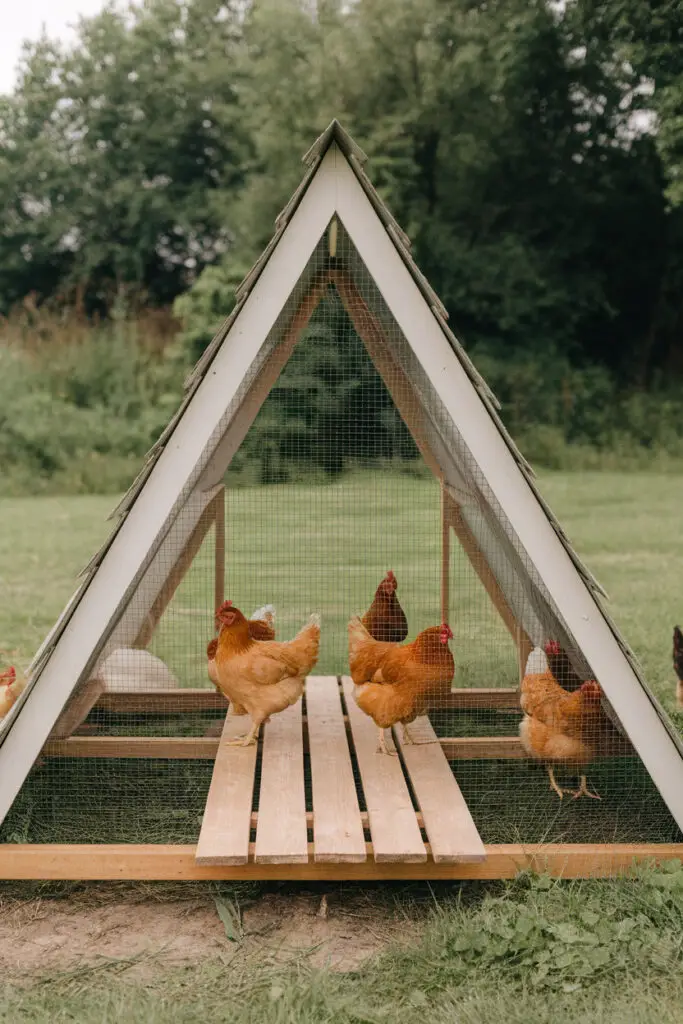
Think of this like a tiny, chicken-sized A-frame cabin. The triangular roof gives it a distinct look, and the angled sides maximize air circulation and natural light. Perfect for tiny yards or even urban spaces.
Why it works:
- Simple, compact design
- Great for warm climates (because of airflow)
- Easy to clean and move if necessary
Plus, if you’re into minimalist design, this is the coop for you. Pair it with some cute chickens and it’ll look like something out of a Pinterest dream.
Design Tips for a Functional Small Chicken Coop
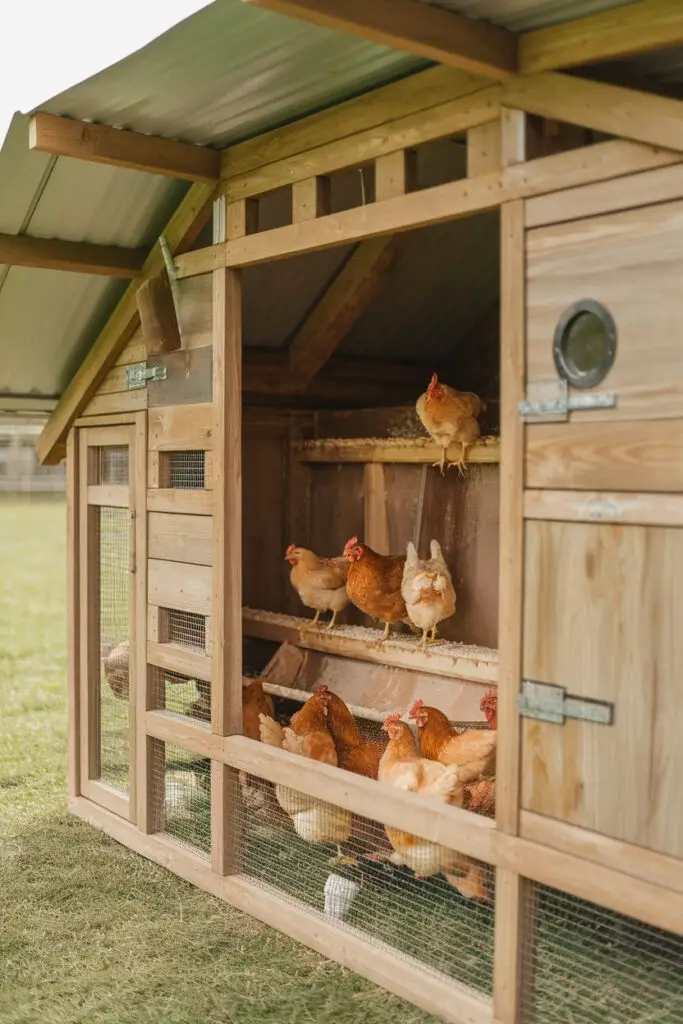
Building a small chicken coop is all about balancing functionality and comfort for your flock, without taking over your backyard. To help you out, here are some top design tips to make sure your coop serves its purpose and looks good while doing it!
Best Layout for Small Coops
Roosts, Nesting Boxes, and Feeder Placement
In a small coop, every inch counts. To make the most of your space, plan your layout carefully. Roosting bars should be placed high enough to give your chickens space to perch comfortably, but don’t crowd them. Nesting boxes can go in a corner or under the roosts, allowing your hens a quiet, private place to lay eggs. Aim for one nesting box for every 3–4 hens to avoid overcrowding.
For feeders and waterers, position them near the roosts but away from the nesting boxes to prevent any dirty water from getting in the eggs. Remember, keeping your food and water accessible but separate from the sleeping area helps maintain cleanliness and prevents waste.
How to Maximize Floor Space
When you’re working with a small area, it’s vital to keep the floor open for your chickens to move around. Use vertical space to your advantage by adding stacked roosting areas or shelves. You can also hang feeders and waterers from the ceiling to free up floor space. And don’t forget that multi-use furniture (like storage boxes that double as perches) can save room while serving multiple functions.
Materials to Use (and Avoid)
Wood, PVC, Mesh
When choosing materials for your small coop, wood is an excellent option for the main structure—it’s durable and natural. If you want to go for a more modern look, PVC pipes can work well for framing or for building doors and windows. Wire mesh is crucial for enclosing the run and keeping your chickens safe, but make sure it’s small enough (1/2 inch or less) to protect them from predators like raccoons or weasels.
Toxic Materials to Stay Away From
Be careful not to use pressure-treated wood for anything your chickens might chew or scratch. The chemicals used to treat the wood can be toxic. Similarly, avoid using any paints or finishes that are not non-toxic or safe for animals. Always opt for natural, chemical-free materials whenever possible to ensure the health and safety of your flock.
Keeping It Clean
Easy-to-Access Doors
When it comes to cleaning your small coop, accessibility is key. Install wide doors that make it easy to reach every corner of the coop. This will allow you to sweep, clean, and change bedding without squeezing through tiny openings or disturbing the chickens too much.
Removable Trays
Install removable trays underneath the roosts to catch droppings and make cleaning quicker. These trays are easy to pull out and dump, and can be lined with newspaper or shavings for an easy cleanup. Just make sure they slide out smoothly for a mess-free experience.
Deep Litter Method
If you’re trying to cut down on your cleaning time, consider using the deep litter method. This involves layering bedding in the coop, allowing it to break down naturally over time. As the litter builds up, it produces heat, which helps with insulation, and it also reduces odor. Just add fresh bedding on top as needed, and turn the litter once a month to keep things fresh.
How to Make a Small Coop Look Cute
Paint Ideas
The outside of your chicken coop doesn’t have to be plain and boring. Consider painting it in fun colors or even a cute theme! If you’re going for a farmhouse look, classic red and white can work wonders. For a more modern vibe, pastel colors like mint green or sky blue add a cheerful touch to your small coop.
Decor and Signs
Don’t forget to add a little personality to your coop with some simple decor or a quirky sign. A sign like “Welcome to the Chicken Coop” or “Egg-cellent Service” can make your chicken’s home extra charming. A few garden gnomes or cute string lights around the coop add a playful vibe and make it feel like a cozy retreat for your flock.
Planters and Window Boxes
If you have space, adding planters or window boxes with flowers can turn your chicken coop into a quaint garden feature. Petunias, pansies, or sunflowers all work well in window boxes and add color while also attracting beneficial insects. Bonus points if you plant herbs like basil or mint nearby—both look beautiful and can be used to freshen up the coop naturally!
Bottom Line: A Small Coop Can Be a Big Success
Designing a small chicken coop doesn’t mean you have to sacrifice comfort or style. With the right layout, materials, and cleaning tips, your hens will thrive in a space that suits both their needs and your backyard. Whether you’re working with a tiny lot or just prefer a more compact design, there are endless ways to make the most of your space without sacrificing functionality.
If you’re still looking for ideas or need inspiration, check out our Chicken Roost Ideas – Creative, Safe, and Comfortable Roosting Options for Your Flock! and 14 Creative Chicken House Ideas for Your Backyard Farm!.
Building a coop is a fun project, and your chickens will thank you with fresh eggs and plenty of happy clucks!

